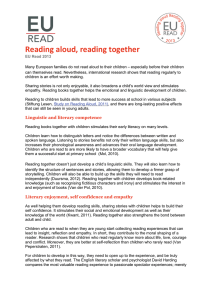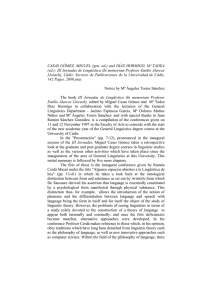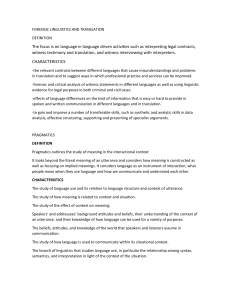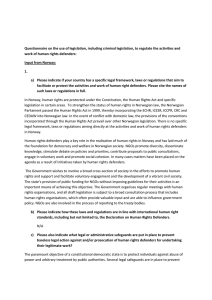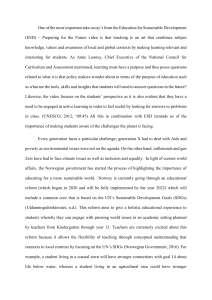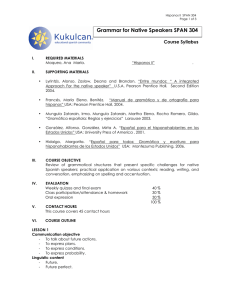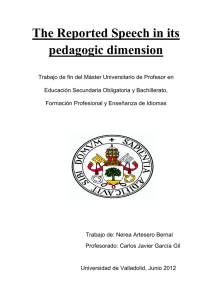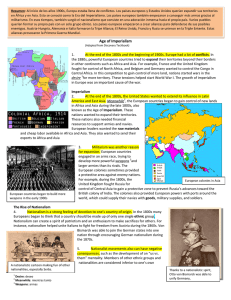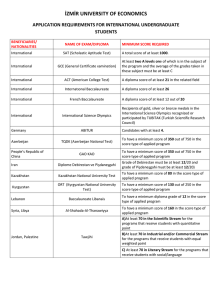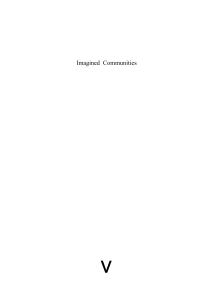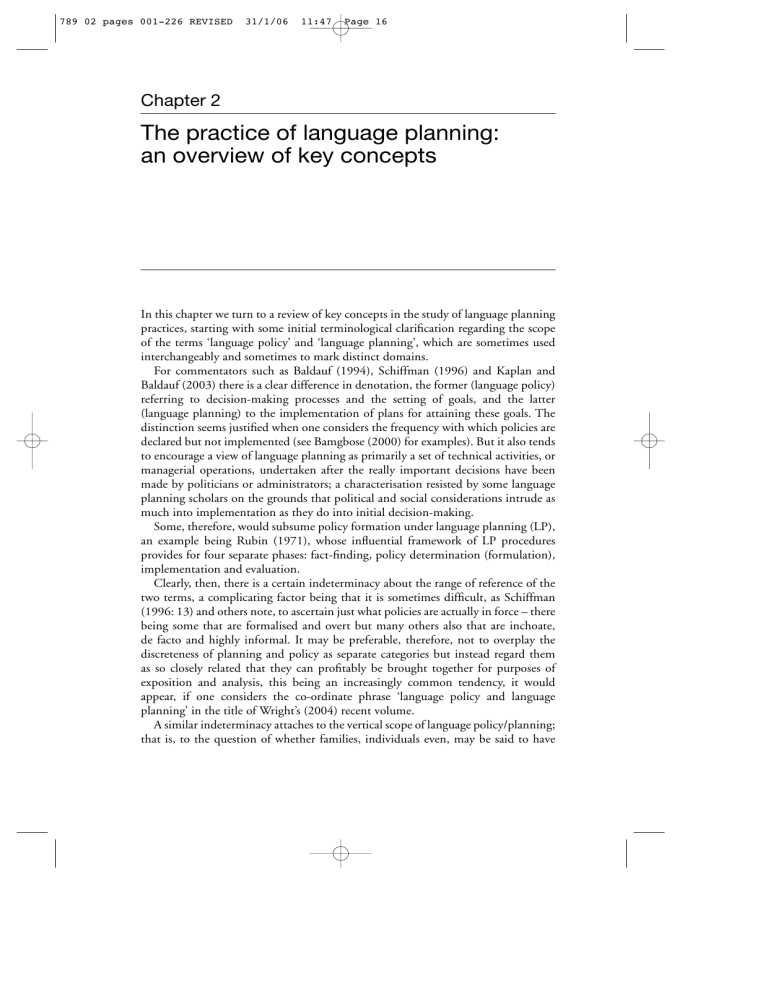
789 02 pages 001-226 REVISED 31/1/06 11:47 Page 16 Chapter 2 The practice of language planning: an overview of key concepts In this chapter we turn to a review of key concepts in the study of language planning practices, starting with some initial terminological clarification regarding the scope of the terms ‘language policy’ and ‘language planning’, which are sometimes used interchangeably and sometimes to mark distinct domains. For commentators such as Baldauf (1994), Schiffman (1996) and Kaplan and Baldauf (2003) there is a clear difference in denotation, the former (language policy) referring to decision-making processes and the setting of goals, and the latter (language planning) to the implementation of plans for attaining these goals. The distinction seems justified when one considers the frequency with which policies are declared but not implemented (see Bamgbose (2000) for examples). But it also tends to encourage a view of language planning as primarily a set of technical activities, or managerial operations, undertaken after the really important decisions have been made by politicians or administrators; a characterisation resisted by some language planning scholars on the grounds that political and social considerations intrude as much into implementation as they do into initial decision-making. Some, therefore, would subsume policy formation under language planning (LP), an example being Rubin (1971), whose influential framework of LP procedures provides for four separate phases: fact-finding, policy determination (formulation), implementation and evaluation. Clearly, then, there is a certain indeterminacy about the range of reference of the two terms, a complicating factor being that it is sometimes difficult, as Schiffman (1996: 13) and others note, to ascertain just what policies are actually in force – there being some that are formalised and overt but many others also that are inchoate, de facto and highly informal. It may be preferable, therefore, not to overplay the discreteness of planning and policy as separate categories but instead regard them as so closely related that they can profitably be brought together for purposes of exposition and analysis, this being an increasingly common tendency, it would appear, if one considers the co-ordinate phrase ‘language policy and language planning’ in the title of Wright’s (2004) recent volume. A similar indeterminacy attaches to the vertical scope of language policy/planning; that is, to the question of whether families, individuals even, may be said to have 789 02 pages 001-226 REVISED 31/1/06 11:47 Page 17 The practice of language planning 17 language policies. Again, different commentators take differing views. Spolsky (2004: 43), for example, following the lead of Cooper (1989: 38), appears content to speak of ‘family language policy’. Grin (2003: 29), on the other hand, argues that this is an overextension of the concept and proposes that it be restricted to the activities of larger-scale social actors that seek to influence the linguistic environment of whole communities. Questionable though such circumscription may be, it is at least practically useful in managing discussion of the field, and for this reason we will follow Grin (2003) and regard language planning policy as prototypically undertaken by agencies of the state at national or regional level, leaving open the question whether individual or family decisions on language constitute policy-making. 2.1 L ANGUAGE, NATIONS AND NATIONALISM LP’s historical association with nation-building and state formation derives from, and reflects, the importance of language in European nationalism. It is appropriate, therefore, in this introduction to LP concepts to comment briefly on the relationship between language, nation, state and nationalism. This, in fact, is not straightforward, for there is, and has been, considerable variability in the role of language in the construction of European national identities and in state formation – the Scots, for example, giving it less weight as an identity marker than the Welsh. Particularly helpful, therefore, is Wright’s (2004) distinction between state nations and nation states, the two being distinguished by the different state formation processes they have undergone. Thus, in the state nations – prototypical examples of which are France, Britain and Spain – the boundaries of the state, or kingdom, were fixed and stabilised first. Thereafter, their rulers initiated a longterm process of cultural, religious and linguistic unification to construct a cohesive national community from previously rather disparate populations. In the nation states, by contrast – Germany being a commonly cited exemplar – national consciousness, a group’s sense of itself as ethnically and historically cohesive, is the antecedent of, and justification for, the group’s attainment of self-government and a political state. Important here is a teleological conception of nationhood deriving from nationalism, an ideology that Kedourie (1960: 9), one of very many academic commentators on nationalism, famously describes as ‘a doctrine invented in Europe at the beginning of the nineteenth century’. Its central tenets, he adds, are that humanity divides naturally into nations (which are thus seen as primordial), that nations have distinct characteristics and that self-government is the rightful, manifest destiny of nations. For Kedourie, the intellectual roots of nationalist ideology lie in the work of German Romantics, specifically, Herder (1744–1803), Fichte (1762–1814) and von Humboldt, W. (1767–1835), who – writing at a time when Germany was no more than a geographical expression – saw in the German language the most plausible evidence for the existence of a German nation, which, because it was a nation, was entitled to its own state. This linkage of language and nation, with a distinct language taken to be an important defining characteristic of a nation, had a profound 789 02 pages 001-226 REVISED 18 31/1/06 11:47 Page 18 Language Planning and Education influence on succeeding generations of nationalist thinkers and can be seen as giving language a foundational role in European nationalism. A common, though not universal, feature of European nationalist movements, then, has been the active consideration given to language matters, one of the more common objectives being the differentiation of the language of the group from related varieties on the same dialect continuum – the North Germanic or Romance continuum, for example – and the fusion of language varieties believed to be internal to the group into a single variety so as to forge a distinct language. This could then form part of the case for political independence where the group had yet to achieve a state of its own, nations being entitled to states. Or, where political autonomy had already been attained, it could reinforce the solidarity and cohesion of the national population. Even where the language of the group was already sufficiently distinct linguistically not to require differentiation from related varieties, an Abstand as opposed to an Ausbau language, to use Kloss’s (1967) terms, nationalist-inspired intervention was not absent. A case in point is Greece, which achieved independence from Ottoman rule in 1832 following an extended nationalist struggle, and whose national self-definition could draw on the resources of a distinctive Orthodox Christianity, a unique alphabet, a glorious past and a language readily identifiable as separate on linguistic grounds. For the new state, however, the issue of what form the written, standard language should take remained open. The solution eventually adopted by the Greek government, albeit in a more extreme form than originally envisaged (Trudgill 2000: 247), was that advocated by a group of purists under the leadership of Adamantios Korais (1743–1833), who had argued for a vernacular form of Greek, but one purified of Turkish and regional dialect influences and closer to classical Greek, this being known as Katharevousa. Progressively institutionalised as the language of government and education during the nineteenth century, this was a variety quite distinct from the everyday spoken vernacular, Dhimotiki, this difference becoming in the twentieth century a major focus of contestation in Greek politics (see Trudgill 2000). Illustrated here is a thesis increasingly upheld by contemporary commentators on language and national identity (e.g. Joseph 2004), which is that – far from being primordial as Fichte proclaimed – national standard languages are cultural and political constructs. The German language itself, specifically standard German, is an example: as Joseph (2004: 98) points out, it emerges from a patchwork of dialects in the sixteenth century, a product both of individuals’ contributions (e.g. Luther’s translation of the Bible) and of wider socio-cultural developments – the introduction of printing, for instance. If the German case can be interpreted as an instance of speakers accepting that their related but sometimes barely mutually intelligible varieties are dialects of a single standard language (Barbour 2000b), there are converse cases where speakers of related and mutually intelligible varieties come to view themselves, because they have distinct ethnic sensibilities and affiliations, as speaking separate languages. Not uncommonly, such perceptions are encouraged by interventions consciously 789 02 pages 001-226 REVISED 31/1/06 11:47 Page 19 The practice of language planning 19 designed to emphasise, and deepen, any relatively small differences between varieties as may already exist, as the cases of Norwegian (see below) in the nineteenth century and Serbian and Croatian in the twentieth century illustrate. The general point here, now a sociolinguistics commonplace, is not just that national standard languages are constructs but that they are often delimited as much, or more, on political as on linguistic grounds. Indeed, as Barbour (2000a: 13) suggests, the emergence of nation states and national standard languages are profoundly implicated in each other: standard languages, he remarks, can be seen ‘as products of modern nations, and nations partly as products of modern communications that allow the effective functioning of states’. This is not to say that political borders necessarily demarcate separate languages. For instance, despite repeated efforts to evolve a distinct standard, speakers of Vlaams (Flemish) in Belgium acknowledge the same official standard, Algemeen Nederlands (Standard Dutch), as Dutch speakers across the border in the Netherlands (see Howell 2000), this example illustrating the complex, variable and contingent nature of the relationship between language and nation. If national standard languages are constructions, the same – in the view of many contemporary scholars – may be said of nations. One part of the construction process of nations is often the forgetting, or psychological denial of just this, and the assertion of exactly the opposite: namely, that the nation’s roots lie in antiquity and that it is an entity ‘so “natural” as to require no definition other than self-assertion’ (Hobsbawm 1983, in Hutchinson and Smith 1994: 76). Among the exponents of these constructivist analyses of nations and national identity are Hobsbawm (1983), cited above, who stresses the role of ‘invented traditions’, national rituals and symbols (e.g. the mass production of statuary) in the production of feelings of solidarity and belonging, and Anderson (1991: 6), whose notion of the nation as an imagined community is much cited: It is imagined because the members of even the smallest nation will never know most of their fellow-members, meet them, or even hear of them, yet in the minds of each lives the image of their communion. For Anderson, print language and the products it gives rise to – newspapers and novels – are especially instrumental in the forging of national consciousness. Billig (1995), meanwhile, in an extension of Anderson’s ideas, draws attention to a phenomenon he calls ‘banal nationalism’, meaning the daily deployment of national symbols – flags, coins, anthems, airline livery, sporting uniforms, botanic emblems (e.g. the thistle) and the like – all of which function to continually reproduce and reinforce national sentiments in the populace. It would be wrong, however, to suppose that there is any unanimity of interpretation. Gellner (1983), for instance, another influential commentator, conceives nationalism somewhat differently. He does not deny that nationalism, with its selective exploitation of rural folk elements, constructs nations (rather than the reverse), but does insist that it should not on that account be taken to be solely an ideological invention of particular intellectuals. It emerges, rather, out of specific social con- 789 02 pages 001-226 REVISED 20 31/1/06 11:47 Page 20 Language Planning and Education ditions, and has, moreover, a camouflaged sociological content he characterises as follows: The basic deception and self-deception practised by nationalism is this: nationalism is, essentially, the general imposition of high culture on society. It means that generalised diffusion of a school-based, academy-supervised idiom, codified for the requirements of a reasonably precise bureaucratic and technological communication. It is the establishment of an anonymous, impersonal society, with mutually substitutable atomized individuals, held together above all by a shared culture of this kind in place of a previously complex structures of local groups, sustained by folk cultures reproduced locally and idiosyncratically by the micro-groups themselves. (Gellner 1983: 57) Different again is Carmichael (2000: 282), who criticises Hobsbawm and Anderson’s emphasis on the constructedness of national cultures for failing ‘to take nationalism seriously as a phenomenon’, for failing to empathise with the ‘real emotional need’ that the invention of traditions can fulfil. In an echo of Edwards (1994: 133), she makes the further point that even if national identities are constructed, they are not constructed out of nothing, but derive from some ‘actual’, non-fictive past solidarity. Illustrated here, one might conclude, is the continuing elusiveness of agreed definitions of nations and nationalism, including the balance of subjective and objective elements in the former’s constitution (see Hutchinson and Smith 1994: 4). To pursue this issue further, however, would take us too far beyond our central focus, which is the role of LP in the processes of construction outlined above – a topic to which we now turn. 2.2 THE ROLE OF L ANGUAGE PL ANNING IN THE CONSTRUCTION OF NATIONAL L ANGUAGES AND NATIONS In this section we review – with suitable exemplification – the processes of standardisation, differentiation, codification, elaboration and purification that are central to the language planning tradition, especially as it relates to nation-building. First, however, we locate these processes with respect to the influential distinction between corpus and status language planning 2.2.1 Corpus and status language planning The conscious, organised interventions that make up LP are customarily divided, following Kloss (1969), into two categories: status and corpus planning. Status planning addresses the functions of language(s) in society, and typically involves the allocation of languages to official roles in different domains – government and education, for instance. Inevitably, these allocative decisions enhance, or detract from, the status of these languages – hence status planning. Corpus planning, by 789 02 pages 001-226 REVISED 31/1/06 11:47 Page 21 The practice of language planning 21 contrast, addresses language form, the code itself, and seeks to engineer changes in that code, central among which, as summarised by Ferguson (1968), are graphisation (the development of writing systems), standardisation and modernisation. The involvement of persons with linguistic expertise is, therefore, typically greater than in status planning, which remains the province mainly of politicians and administrators. It would be unhelpful, however, to overplay the distinction, useful though it is, for not only are corpus and status planning intertwined – changes in the form of a language being a usual prerequisite of its allocation to new functions – but both are typically driven by political considerations extending well beyond language per se. Moreover, the once commonly accepted notion that corpus planning follows, and is dependent on, status planning has recently been questioned (see Fishman 2000: 44): corpus planning, the evidence suggests, can in fact prepare the ground for status changes as well as consolidate them after they have taken place, or both can, indeed, proceed simultaneously. Nowhere, perhaps, is such interdependence better observed than in one of the main activities of LP – standardisation, which we now discuss along with codification and differentiation, its close associates. 2.2.2 Differentiation, standardisation and codification In both state nations and nation states linguistic unification, or convergence (see Wright 2004: 42), was an important instrument for fashioning a cohesive national culture with which the population could identify. One aspect of this (see above) was conscious differentiation of the national language variety from other related varieties through a process known, following Kloss (1967), as Ausbau (German for ‘building away’), involving the selection and promotion of those variants in the national variety dissimilar to equivalents in the other varieties on the same dialect continuum (Wright 2004). A classic example is the nineteenth-century differentiation of Norwegian from Danish, but similar interventions can also be observed in the cases of Macedonian/Bulgarian, Serbian/Croatian and Urdu/Hindi – in all of which linguistic distancing served to underscore political and national difference (see Fishman 2000: 45).1 A second aspect of unification, equally important, is standardisation, the construction – and subsequent dissemination – of a uniform supradialectal normative variety. This, it is widely agreed (Milroy and Milroy 1998, Joseph 2004), has both a linguistic and an ideological dimension. Linguistically, a key feature is the creation of a uniform written variety, achieved by replacing optional variants with invariable forms (Milroy, J. 1999), the ultimate aim being, in Haugen’s (1966b) celebrated phrase, minimal variation in form and maximal variation in function. Complementary here, and necessary – since without it there could be no enduring standard – is codification, the process of giving explicit definition to the norm, principally through the production of authoritative grammars, dictionaries, spellers and the like. These contribute to the dissemination of the standard by making clear its rules and boundaries. This standard is, however, an abstract idealisation rather than an 789 02 pages 001-226 REVISED 22 31/1/06 11:47 Page 22 Language Planning and Education empirically verifiable reality in that while some speakers may approximate to the standard they never ‘exactly conform to the idealisation’ (Milroy, J. 1999: 18), an observation that has led several scholars (e.g. Milroy and Milroy 1998, Joseph 2004) to refer to the standard language as an ‘idea in the mind’, a sort of platonic form. Standardisation is also an ideological process in a number of respects. First of all, the standard is commonly based on the variety (or variants) spoken by the most powerful sector of society, whose norms are subsequently held up for less privileged social groups to emulate. This, it is sometimes argued, consolidates and helps legitimate the economic and social dominance of elites. Acceptance and acquisition of the standard becomes necessary for socio-economic mobility. Second, standardisation gives rise to what Milroy and Milroy (1998) refer to as a ‘standard language ideology’, a constellation of beliefs propagated by the media, government agencies or influential opinion formers, and widely accepted by the public, whose principal constituents may be summarised as follows: 1. Identification of the standard language (e.g. standard English) with the whole language (see Milroy, J. 1999: 18) 2. Belief in the superiority of the standard language over other varieties or dialects 3. Development of the notions of correct and incorrect language, and the idea that there is only ‘one correct form of the spoken language’ (Milroy, L. 1999: 174), part of the population coming to stigmatise their own speech as ‘incorrect’ or ‘ungrammatical’. Language change also comes to be associated with decay or corruption 4. Identification of the standard language with the national language, a symbol of national identity and source, potentially, of national pride. Turning now to the role of LP in standardisation, we immediately encounter a complicating factor, inimical to generalisation, which is the considerable variation in the routes taken toward the building of a standard language. In some cases, for example, standardisation is a protracted process, in others relatively swift; in some a standard is imposed from above, in others it emerges gradually from below in a more organic process; in some standardisation commences before the era of high nationalism, in others it coincides with or post-dates that era; in some standardisation produces a single accepted standard, in others the outcome is two or more competing standards; and so on. It may be more appropriate, therefore, to proceed with some illustrative and contrasting examples. A convenient example of standardisation as a long-term process, and one, moreover, where formal, state-directed LP is not especially evident, would be English. In this case, the standardising process is generally thought to have commenced in the Renaissance period with Caxton’s introduction of printing to England in 1476 and his adoption of the prestitious south-east Midlands variety, centred on London, as the basis of the print language. The position and prestige of this variety was steadily entrenched by its use in administration and literary production (e.g. in the works of Spenser, Marlowe and Shakespeare). In due course it received the attention of the eighteenth-century prescriptivists, all of whom were desirous of linguistic order and 789 02 pages 001-226 REVISED 31/1/06 11:47 Page 23 The practice of language planning 23 keen to secure the language from decay, and whose works – the proposals of Swift (1712), the grammars of Duncan (1731) and Bishop Lowth (1762) and, most notably, the dictionary of Dr Johnson (1755) – advanced the construction of modern standard English.2 Alongside the efforts of these individuals, and not forgetting the nineteenthcentury creation of the Oxford English Dictionary (OED), one also needs to set wider social forces conducive to linguistic convergence and the dissemination of a uniform standard: the rise of print capitalism (Anderson 1991), industrialisation and increased urbanisation in the eighteenth and nineteenth centuries, military conscription, the introduction of mass education after 1870 and, finally, the twentiethcentury development of a mass media. The general picture, then, is of a steady, gradual evolution of a standard language from the speech of an elite sector of society, a process sometimes quickened by the interventions of individuals (e.g. Johnson), or by non-governmental institutions, but facilitated fundamentally by the social forces cited above, all of this occurring with little direct intervention by the state. Contrasting with English, and now – thanks to the seminal writings of Haugen (1966a) – a regular textbook example of LP, is the case of the development of standard Norwegian. This differs from English both in its chronology – the standardisation of a distinct Norwegian only commencing in the nineteenth century following independence from Denmark in 1814 – and in its very clear exemplification of the influence of nationalism and romanticism in the standardisation process. At independence there was no standard Norwegian, Danish having long been entrenched as the written language of Norway.3 Such a situation, however, was profoundly uncongenial to contemporary nationalist and Romantic notions of the nation, which emphasised, as we have seen, the importance of a distinctive language as a significant, even defining, element of a unique national identity. It is no surprise, therefore, to find that as the century progressed and especially from the 1830s on (see Vikør 2000: 112), questions of language and national identity loomed large in the preoccupations of the Norwegian intellectual class. There were, however, opposing views as to how a distinct Norwegian identity could be defined. One influential strand of opinion sought – in true Romantic fashion – to retrieve a Norwegian identity not from the sullied present but from a more pristine and distant past, from a medieval Norse culture, traces of which lived on, it was believed, in the popular culture of remote rural Norway. The implication, in linguistic terms, was that if there was to be a true Norwegian, it would need to be based on the popular rural dialects of the time. Inspired by this Romantic vision, and instrumental to its practical realisation, was Ivar Aasen (1813–96), a self-taught linguist and himself a native speaker of a rural dialect, who set out to codify a common written standard out of, and for, the diversity of rural dialects. His grammar of 1864 and dictionary of 1873, the fruit of long travels around the Norwegian countryside collecting and comparing dialect forms (see Linn 1997), laid the foundations for what – with some refinements and modifications – became known as Landsmål (the language of the country), a variety 789 02 pages 001-226 REVISED 24 31/1/06 11:47 Page 24 Language Planning and Education recognised by parliament in 1885 to have equal validity with Dano-Norwegian and renamed Nynorsk (New Norwegian) in 1929. Today, despite the unfavourable prognostications of some of Aasen’s contemporaries (see Linn 2004: 228), who believed it to be too much of an artificial contrivance,4 Nynorsk persists as one of Norway’s standard languages – albeit a lesser used one than its competitor. This competing standard, the product of a second line of nineteenth-century language reform, emerged from an alternative conception of Norwegian nationhood, one that looked to the urban, middle-class culture of the time rather than the distant past as a more relevant resource for the construction of a modern Norwegian identity (see Vikør 2000: 113). In linguistic terms, the implication was that the Norwegianised Danish spoken in the towns rather than Aasen’s rural dialects was an appropriate foundation for a modern written Norwegian standard. What was needed, therefore, were adjustments to the existing Danish standard to mark it as more distinctively Norwegian: the replacement, specifically, of foreign lexicon with ‘native’ Norwegian vocabulary, and orthographic changes that would more authentically reflect the everyday pronunciation of educated, middle-class Norwegians. Leading this reform programme, or more precisely one faction within it, was the teacher Knud Knudsen (1812–95), whose work is generally acknowledged as laying the basis of a DanoNorwegian that received recognition in the official revision of the standard of 1907 and that was subsequently renamed Bokmål (book language) in 1929. By the early twentieth century, then, there were two standard languages in Norway, a situation sufficiently uncomfortable as to encourage attempts at a rapprochement between Bokmål and Nynorsk, from which, it was hoped, a single fused standard would emerge. The story of these ultimately unsuccessful endeavours, fascinating though they are, lies, however, beyond the scope of this chapter, since the main aim of this thumbnail sketch has been to bring out the contrast with English, this lying primarily in the more obvious nationalist motivation driving Norwegian standardisation, the more direct and self-conscious LP involved, and in the more overtly political character of the process. There is, however, a further reason for citing the Norwegian case here, which is that it was one of the sources for Haugen’s (1966c) elaboration of a model of language planning, since refined (Haugen 1983), which continues to be influential. The model, in its original form (Haugen 1966c/1972: 110), identifies four processes involved in developing a standard language: (a) selection of norm, (b) codification of form, (c) elaboration of function and (d) acceptance by the community. Selection here refers to the choice of one or more dialects to serve as the basis of the standard, and is exemplified in the Norwegian case by Knudsen’s preference for the speech of the urban middle class over rural dialects as the basis of a new Norwegian standard. Codification, of which we have already spoken, involves stabilising, or fixing, the form of the language through the production of normative grammars and dictionaries: Aasen’s 1864 grammar and 1873 dictionary would be examples here. Elaboration, sometimes referred to as ‘cultivation’, aims at an expansion of the language’s functional range, allowing it to serve, for example, as a medium of scientific and technical discourse. Typically, this requires the develop- 789 02 pages 001-226 REVISED 31/1/06 11:47 Page 25 The practice of language planning 25 ment of new registers and the creation of new lexical items – especially in the fields of science, technology and economy, an activity that has led some writers (e.g. Ferguson 1968) to prefer the term ‘modernisation’ and others to equate elaboration with language modernisation. If codification lies firmly in the domain of corpus planning, and elaboration is a combination of corpus and status planning, the final element in Haugen’s (1966c) model – acceptance – can reasonably be placed in the category of status planning in that it involves conscious dissemination of the standard and orchestrated efforts to persuade the community to accept the norm. That this is necessary, and often difficult, is amply illustrated in the numerous instances where the standard, as developed by committees, academies or individuals, is rejected, or resisted, by the community. One example of this, discussed in more detail in Chapter 4, is the ambivalent and sometimes hostile attitude of many native Breton speakers toward the standardised, literary variety of Breton developed in the twentieth century, a form they feel is somewhat artificial and strained. Not altogether dissimilar is the situation in the Biskaia province of the Basque country, where the new unified written Basque, Euskara batua, has yet to gain full acceptance, principally because it tends to reflect more closely the Gipuzkoa variety (Fishman 1991; Gardner, Serralvo, Williams 2000: 330). Illustrated here, and a quite general phenomenon,5 is the reluctance speakers may experience in accepting a standard based on a dialect quite different from their own, and one that they feel does not, therefore, adequately acknowledge their particular identity. Estrangement from the standard may also occur, however, for other reasons. If, for example, the path to standardisation is an archaising one in which the written standard is constructed from some older, more classical and therefore putatively more authentic variety, then a diglossic situation may develop in which the standard is used in high (H) functions (e.g. education and administration) and a more demotic, everyday variety in low (L) functions (e.g. home, informal interaction). Over time, however, resistance to the written standard, the high form, may set in, simply because it comes to be perceived as remote from everyday life, as an unwelcome artifice and as an impediment to education Such, one might argue, has been the situation in Greece, where, as we remarked earlier, the contrast between Katharevousa, a purified, artificial variety harking back to a classical Greek past, and Dhimotiki, a popular, vernacular variety, was a focus of political contestation for much of the twentieth century up to 1974, when – with the overthrow of the ruling military junta – the former lost all official and popular support (see Trudgill 2000: 248). Gaining acceptance of the standard is, then, a potentially fraught business, but – recalling Romaine’s (2002: 19) point that LP interventions tend to be more effective to the extent that they work with rather than against prevailing social currents – it is possible to identify, at a very general level, circumstances that are conducive to success. Thus, where a standard emerges gradually out of the speech of the elite and steadily accrues prestige, where there are material and social incentives for acquisition 789 02 pages 001-226 REVISED 26 31/1/06 11:47 Page 26 Language Planning and Education and access is relatively easy, or where there are clear and widely understood ideological reasons for adoption – nationalist reasons for example – acceptance of a dominant standard language is more likely; this, almost paradoxically, rendering conscious LP intervention less necessary. Conversely, where standardisation proceeds relatively swiftly and is more obviously orchestrated, and the standard consequently has less time to accrue prestige to itself, where it is seen as an artificial construction imposed from above, where regional identities remain strong, or where material incentives and ideological motives are relatively weaker, acceptance will be correspondingly more difficult, rendering conscious promotion simultaneously more necessary and less likely to succeed. One might add here that the prestige of the standard, a factor crucial to its successful dissemination, is widely acknowledged to be significantly enhanced by the literary output of creative writers, translators, and other literary figures. An example would be William Morgan’s 1588 translation of the Bible into Welsh, which is recognised (see Chapter 4) as laying the foundation for a prestigious and eventually widely accepted standard written Welsh. Similarly, Yannis Psicharis’s (1854–1929) celebrated novel To Taxidhi Mou (‘My Journey’), the first literary work published in Dhimotiki (Trudgill 2000: 247), is recognised as immeasurably enhancing the credibility of Dhimotiki as a potential alternative standard to Katharevousa. With this mention of individuals who have had a significant impact on language standardisation, we arrive at a juncture where it is convenient to introduce other agencies active in LP. In the next section, accordingly, we turn attention to language academies and their role, specifically, in elaboration and language purification. 2.2.3 Elaboration, purism and the role of language academies Individual writers, philologists and linguists – such as Johnson, Webster, Aasen and Psicharis – have, as we have seen, been significant players in LP, but ranking alongside them in historical importance are formal institutions, the academies, to whose activities we now turn. 2.2.3.1 Language academies The earliest of these were the Accademia della Crusca of Florence founded in 1572 and, more eminent still, the Académie Française, which started out as a literary grouping led by Valentine Conrart before it was converted into an official state organisation by Cardinal Richelieu in 1634. Operating at a time when France was beginning to emerge from a period of civil disorder and religious wars, and when the French vernacular was beginning to displace Latin in literary and administrative functions, Richelieu’s aim was to pull the literary elite into the orbit of his influence and harness it to his objective of consolidating civil order and the power of the monarchy. The particular function of the new Academy, however, as set out in the statutes of foundation, was to purify the vernacular, expand its functions and regulate the language so as to ‘render it pure, eloquent and capable of treating the arts and 789 02 pages 001-226 REVISED 31/1/06 11:47 Page 27 The practice of language planning 27 sciences’ (cited in Cooper 1989: 10). From the outset, therefore, the Academy, like its Florentine counterpart, was a prescriptive, purifying institution dedicated to the codification of a literary standard that could not, and did not, admit words felt to have no place in polite society. The members of the Academy, the forty ‘immortals’ as they became known, were in fact largely untutored in linguistic matters, which may partly explain the slightness of their corpus planning efforts, a rather poorly regarded dictionary only appearing in 1694. Nonetheless, the Academy’s very existence, and the prestige it commanded, set an example for others beyond France to follow, most notably the Bourbon monarch Philip V, who established the Real Academia Española in Madrid in 1713. Its motto, ‘Limpia, fija y da esplendor ’ (purify, stabilise and glorify), is an apt summary of its aim and of its work, which in due course led to the production of a dictionary in 1730 and a grammar in 1771, the latter building on Nebrija’s Gramática castellana of 1492 (see Joseph 2004: 103; Edwards 1994: 157). The Spanish Academy, in turn, served as a model for the establishment in the nineteenth century of a string of independent Latin American academies – Colombia (1871), Mexico (1875), Ecuador (1875), El Salvador (1880), Venezuela (1881), Chile (1886), Peru (1887) and Guatemala (1888) (Guitarte and Quintero 1974: 324), which in the twentieth century came together with the Real Academia Española to found an overarching Asociación de Academias de la Lengua española, dedicated, among other things, to combating centrifugal tendencies among national varieties of Spanish. The Académie Française, meanwhile, which today acts as a bulwark against the contaminating influence of the English language, was more directly the inspiration for the foundation of academies in other European countries – the Swedish Academy (1786), the Russian Academy (1783) and the Hungarian Academy (1830), for example. Notably absent here is any English language academy. Proposals for such an institution, along French lines, were in fact advanced by Defoe (1702) and Swift (1712) in England and by John Adams (1780) in the United States, but they foundered on the objections of influential individuals (e.g. Johnson) and on the Anglo-Saxon aversion to formal institutional regulation of language. The work of codification and elaboration thus fell to individuals and private institutions (e.g. the OED). In the twentieth century many more academies and LP agencies were founded, most conspicuously this time in colonial and post-colonial Africa and Asia. Wellknown examples include Dewan Bahasa dan Pustaka (the Institute of Language and Literature), established in Malaysia in 1956,6 the Indonesian National Language Council, set up in 1947 and later retitled the Centre for the Development and Preservation of the National Language in 1975, and the International Language Committee (for East Africa) established in 1930 to promote the standardisation of Swahili. With Tanzanian independence in 1961 this body was renamed the Institute of Swahili Research and transferred to the University of Dar-es-Salaam, where – alongside the National Swahili Council (Baraza la Kiswahili) – it is today responsible for Swahili research, vocabulary elaboration and language promotion. Like the older European academies on which they were modelled, the central 789 02 pages 001-226 REVISED 28 31/1/06 11:47 Page 28 Language Planning and Education focus of these newer agencies has been the development of the national language, principally through codification, publication and elaboration of vocabulary. The latter, always a more iterative undertaking than either graphisation or codification (see Fishman 1974: 23), has been a particularly energetic area of activity: by the 1980s, for example, up to 500,000 new terms had been created for Bahasa Indonesia (Alisjahbana 1984), and a significant, though lesser, number for Kiswahili (Ohly and Gibbe 1982), the majority in the fields of science, technology and education. That these were the domains predominantly targeted for lexical elaboration indicates that the dominant motive was not the reinforcement of good taste or refinement – as with some of the older academies – but modernisation; that is, the expansion of the lexicon to facilitate scientific/technical discourse and to provide for ‘intertranslatability with other languages in a range of topics and forms of discourse’ (Ferguson 1968: 28). Recent decades have seen the establishment of a further wave of LP agencies, but these operate in a quite different socio-political and intellectual context, one that is more suspicious of ‘linguistic streamlining’. Compared to their predecessors, they also tend to have a wider remit, reflected in a greater degree of engagement in status planning. One of the main tasks of the recently established Welsh Language Board (Bwrdd yr Iaith Gymraeg),7 for example, is the supervision of measures intended to bring Welsh to a position of equality with English in Wales (see Chapter 3). Similarly, the (Catalan) General Directorate for Language Policy (DGPL), established in 1980 following the enactment of the 1979 Catalan Statute of Autonomy, is involved in implementing and overseeing legislation aimed at ‘normalising’ Catalan; that is, elevating it to functional equality with Spanish (castellano). In South Africa, meanwhile, the Pan South African Language Board (PANSALB), formally inaugurated in 1996 as an independent statutory body and a key South African language planning agency, is charged – among other things – with working to promote the use of previously marginalised languages now awarded official status – languages such as Tshivenda, Xitsonga, isiNdebele and siSwati – and with investigating alleged violations of language rights provisions (see Marivate 2000). We can conclude, then, that formal institutions backed by the state continue to play an important role in LP. With the passage of time, though, their functions have diversified into status planning, and their ideological biases have altered – at least in some cases. This is perhaps most clearly exemplified by PANSALB, which, far from standardising and promoting a single hegemonic national language within the borders of the state, as might once have been the case, today promotes an officially sanctioned multilingualism. 2.2.3.2 Lexical elaboration Turning now to examine in a little more detail the operations involved in lexical elaboration, we find that they too have an ideological as well as a technical dimension in that developers of new terminology confront a set of choices, each of which carries a political or ideological charge. One choice, for example, and sometimes the 789 02 pages 001-226 REVISED 31/1/06 11:47 Page 29 The practice of language planning 29 soundest for being least prescriptive and most realistic in a world of easy electronic communication, is to give official recognition to borrowed terms already widespread in popular usage. This, of course, circumvents the problem of acceptance but may encounter puristic and nationalistic objections: academies in some countries, for instance, are resistant to borrowings from English. Where, however, there is no term currently available for a particular concept, or where spontaneous, popular borrowings are considered unacceptable, then intervention to coin a new lexical item (‘lexication’) may be thought necessary, in which case further options present themselves. An initial binary choice is between creating a new term from indigenous linguistic resources or systematic borrowing from another language. If systematic borrowing is preferred, yet further decisions are needed: for example, on the source language, and on the degree to which the loan should be indigenised through phonological, graphological or morphological modification. If creating new terms from indigenous linguistic resources is favoured, then a variety of techniques can be exploited: for example, loan translation (translating a foreign word); semantic shift or meaning transfer (that is, giving new meanings to existing words); building new terms from the roots and affixes of indigenous words; and compounding. These processes are commonly illustrated with examples from Indonesian (see Cooper 1989; Foley 1997; Kaplan and Baldauf 2003) – probably because terminology elaboration in this case has exploited not one but a variety of sources and techniques, and because the operations involved are well documented (Alisjahbana 1976). For convenience, then, we also use Indonesian as our source of examples, as in Table 2.1. Whether one borrows a word from a foreign language or draws on indigenous resources to coin new lexical items, there are practical and ideological consequences. Borrowing, for example, can facilitate ‘intertranslatability’, but it may also make the word more difficult to understand – at least for some sectors of the population. It may also, more seriously, be seen as compromising the authenticity of the national language, though such sentiments usually vary in strength depending on the source language. The use of indigenous language sources is not problem-free either, however. For modernisers, for example, it may be seen as an atavistic parochialism. Uncomfortable questions may also arise regarding which indigenous languages and varieties are to be the providers of roots and affixes. And finally, looming over all, is the issue of the acceptability of new coinings. Here, there appears to be agreement that it is easier to gain acceptance for a coining where there is no alternative term already in use, or no usage at all (Cooper 1989: 151). Far more difficult is gaining acceptance for coinings intended to replace spontaneous borrowings already established in popular discourses on science, sport, economics and commerce, politics, popular entertainment, computing and so on. Indeed, all too often the neologisms devised by academies never catch on, becoming ‘dead butterflies pinned into collections’ (Lewis 1999: 75) – beautiful but lifeless because they remain unused in newspapers, books or conversation.8 789 02 pages 001-226 REVISED 30 31/1/06 11:47 Page 30 Language Planning and Education Table 2.1 Vocabulary elaboration: examples from Indonesian (see Foley 1997, Kaplan and Baldauf 2003, Alisjahbana 1976) ‘Lexication’ technique Examples 1 Borrowing from European languages (e.g. English) with graphological/phonological adaptation taksi [taxi] universitas [university] demokrasi [democracy] 2 Semantic shift/meaning extension urak [root] ⇒ [tendon] pembulah (pem [to] + bulah [bamboo] ⇒ [vein] 3 Borrowing of Sanskrit roots and affixes a. wan [person of ] + warta [news] ⇒ wartawan [journalist] b. wan [person of ] + sastera [literature] ⇒ sasterwan [man of letters] 4 Use of roots and affixes of indigenous Indonesian languages affixes: ke- -an. root: bangsa [people] ⇒ ke-bangsa-an [nationality] 5 Compounding anak kalimat [child of a sentence] ⇒ [phrase] anak uang [ child of money] ⇒ [interest] Comments: Cooper (1989: 152) observes that borrowings from English and other European languages tend to be more common in the domains of science, technology, economics and politics, and those from Sanskrit in literature and the arts. Foley (1997: 414) remarks, meanwhile, that in coining new words Indonesian language planners tend to look first to indigenous languages as a source, then to Sanskrit (the Indic language of past Indonesian empires) and finally to English; priorities which reflect, of course, a concern for national identity and authenticity. This is not to say that there have not been successes in the dissemination of new terms, especially where nationalist sentiments have been mobilised behind the replacement of foreign borrowings – as, for example, in the Turkish language reform of the 1930s (see below). Generally, however, it is difficult to disagree with Wright’s (2004: 60) view that today, in an age of globalisation, open borders and electronic communication, it is increasingly difficult, and less acceptable, to police the national language and shut out foreign borrowings, which these days often derive from English. There has, moreover, been a shift in attitudes towards borrowings, which are now just as likely to be regarded by linguists and academics as indicators of vitality as of corruption. An example might be the reflections of Kuneralp (1981), a Turkish diplomat and writer, on the Turkish language reform (cited in Lewis 1999: 152): if we are fanatical partisans of pure Turkish, when we cannot find a pure Turkish word to express the meaning we want, we load that meaning on to some other word and, for the sake of our socio-political beliefs, cast aside the Arabic, Persian or Western word that perfectly meets our needs. In this way we impoverish our language, we obliterate its nuances, we deprive it of clarity and thrust it into a 789 02 pages 001-226 REVISED 31/1/06 11:47 Page 31 The practice of language planning 31 tasteless form. Whereas, the more numerous the sources a language can draw on for words, the more explicit, the more colourful, the more copious it becomes … The world we live in is steadily diminishing in size, the nations are growing closer together, their languages are influencing one another and thereby becoming jointly enriched. (Translation from Lewis 1992: 2–3) 2.2.3.3 Linguistic purism Implicitly and explicitly, we have made reference in the preceding discussion to linguistic purism, an ideology that has been influential in the work of language academies and individuals and that therefore merits brief attention. As Thomas (1991: 75) suggests, there are various types of purism: elitist purism, for example, which scorns non-standard and regional usages, or archaising purism, that locates the purest, truest expressions of the language in the remote past. Another type, perhaps more common, and one we concentrate on here, is ‘xenophobic purism’ (Thomas 1991), which seeks to purge the language of foreign elements. As one might expect, xenophobic purism is closely connected to ideologies of nationalism, to the Herderian notion that the national language cannot be authentically national if it too obviously or abundantly contains borrowed elements. It tends, therefore, to be more evident in periods of intense nation-building. It also tends to give most attention to the lexicon, though, as Thomas (1991) points out, any area of language – phonology, morphology, orthography – can in principle be the focus of puristic agitation. Typically, then, puristic interventions target foreign borrowings in the lexicon, and endeavour to replace them with words constructed from indigenous national sources – dialects, archaic popular forms, ancient texts. Examples of this kind of intervention abound – both today in, say, the continuing struggle of the Académie Française against incursions from English and, more prolifically, in the nineteenth and early twentieth centuries, eras of high nationalism. In nineteenth-century Finland, for instance, linguists strove hard to eject Swedish terms in favour of authentically Finnish neologisms (Wright 2004: 58), and the Italian fascist regime (1922–45) was keen to eliminate any words of obvious foreign origin from public display. One of the most remarkable cases of language intervention, however, and one where there is a clear fusion of purism and nationalism, was the Turkish language reform, initiated in the 1930s. The political context of the reform – essential to understanding its motivation – was the emergence in 1923 of a new Turkish republic from the debris of the old Ottoman empire. Its first president and founding father, Kemal Atatürk (1881– 1938), was determined to forge a new national identity that was distinctively Turkish, secular and modern, and to this end introduced a whole battery of social, legal and cultural reforms. These included a western calendar system (1925), a new secular legal code, western-style surnames (1934), an extension of the rights of women, the closure of madrasas (religious schools) and a ban on the wearing of the fez (1925). Language did not long escape the attention of the reformers, and in 1928 the 789 02 pages 001-226 REVISED 32 31/1/06 11:47 Page 32 Language Planning and Education Arabo-Persian alphabet was formally replaced by a Latin alphabet, the so-called ‘Gazi alphabet’ (Lewis 1999: 35). Radical though this was, it was soon eclipsed by a still more ambitious project: the wholesale purging of the large number of words of Arabic or Persian origin that had over centuries infiltrated into written Ottoman Turkish,9 and their replacement with words of Turkish origin so as to forge a pure Turkish (Özturkçe), free of the ‘yoke of foreign languages’ 10 and less distant from popular speech. The project was unleashed in its fullest vigour at the close of the first Kurultay (Turkish Language Congress) in October 1932 with what can appropriately be described as a language mobilisation. All over Turkey, teachers, doctors, civil servants, tax collectors and administrators were sent out to collect words from Anatolian dialects to replace those of Arabic origin. Scholars, meanwhile, scoured old texts and dictionaries of Turkic languages in search of replacements for the offending Arabic-Persian words. The results of these endeavours were published in 1934 in a volume titled Tarama Dergisi. The following year – for the benefit of a wider public – lists of replacement words proposed by the press were published under the title Cep Kilavuzu (Pocket Guide from Ottoman to Turkish) (Lewis 1999: 55). Inevitably, perhaps, in such a large undertaking, involving many persons with little or no linguistic expertise, there were excesses. Thus, while some neologisms were created on sound philological principles by, say, compounding existing Turkish roots and affixes, others were little more than concoctions arbitrarily plucked from the imagination (see Lewis 1999). And, in cases where no Turkish equivalent could be found for an essential word, ingenious efforts were often made to fabricate a Turkish etymology for them. The details of this neologising, and of the purification work conducted by the Türk Dil Kurumu (TDK) (Turkish Society for the Study of Language) after Atatürk’s death, lie beyond the scope of this chapter however. All we can include here is a brief mention of the overall outcome, which is that by the 1970s written Turkish had been so utterly transformed that young Turks could barely comprehend texts from the 1920s or 1930s. And it is this, combined with the impoverishment of the lexicon and of register variation resulting from the whittling away of Ottoman words, that leads Lewis (1999) to refer to the reform as a ‘catastrophic success’. He admits (1999: 150), though, that not all is lost: old words are re-emerging, there is greater willingness to countenance useful borrowings and the object of puristic concerns is now not so much Ottoman vocabulary but incursions from English. For language planners, then, the Turkish language reform is a remarkable, and somewhat unusual, example of successful corpus planning. But it also illustrates the unforeseen and adverse consequences that can flow from such large-scale intervention. 2.2.4 The role of status planning Unlike corpus language planning, whose domain is language itself (see above), status planning – that is, intervention targeted at the societal functions of language – usually involves simultaneous activity across several social domains: the workplace, 789 02 pages 001-226 REVISED 31/1/06 11:47 Page 33 The practice of language planning 33 local government, the family/home, the law, the media, education and so on. An example would be Quebec in the 1970s, where the ruling nationalist party, the Parti Québécois, implemented a series of measures to enhance the status of French relative to English. The most far-reaching of these – enacted in 1977 – was Bill 101 (the ‘Charter of the French Language’), which required, among other things, businesses with over fifty employees to obtain a ‘francisation’ certificate attesting that French was the normal language of internal communication (the workplace domain). Newly-arriving immigrants were required to send their children to French-medium public schools (the education domain), and, most controversially, languages other than French were banned from outdoor signs (e.g. shop signage, advertising hoardings, traffic signs). Provisions of this restrictiveness amounted to a rejection of the federal government’s bilingual/bicultural policy, the rationale being that in a country where the dominant language, English, was so strongly associated with opportunity and social mobility, liberal pluralist policies offering freedom of language of choice could only condemn French to long-term decline. The only effective remedy, it was believed, was an active counter-hegemonic policy aimed at turning Quebec into a unilingual French sphere (see Schmidt 1998). Another example of status planning implemented across a range of domains is the ‘Speak Mandarin’ campaign in Singapore. Initiated in 1979 by the then prime minister Lee Kuan Yew for a mixture of educational, cultural and communicative reasons (see Bokhorst-Heng 1999 for more detail), the aim was to persuade Chinese Singaporeans to give up speaking ‘dialects’ (e.g. Hokkien, Teochew, Hakka, Cantonese) in favour of Mandarin. As with the promotion of French in Quebec, a variety of instruments were used: advertisements in the press and on television urged a shift to Mandarin, and a prohibition was placed on the use of ‘dialects’ on public service radio and television (the media domain); provision of adult education classes teaching Mandarin was expanded (the education domain); for some occupational groups (e.g. the army) promotion and salary enhancements were linked to passing Mandarin tests (the workplace domain); and shop owners and stallholders were asked to provide Hanyu Pinyin11 signs or names for their premises. Recent census statistics suggest that the campaign has enjoyed a fair degree of success, not just in the public domains overtly targeted but also in the family/home domain. By 2000, for instance, the reported use of ‘dialects’ in the home had fallen to 23.8 per cent of respondents from the higher figure of 59.5 per cent in 1980 while over the same period use of Mandarin in the home rose from 10.2 per cent to 35.0 per cent (census figures cited in Pakir 2004: 122). 2.3 L ANGUAGE PL ANNING IN EDUCATION Of all the domains mentioned above, education is probably the most crucial, sometimes indeed bearing the entire burden of LP implementation. The reasons are straightforward: education in most countries is largely funded and thus controlled by the state; schools are one of the key agencies of socialisation; school pupils are a 789 02 pages 001-226 REVISED 34 31/1/06 11:47 Page 34 Language Planning and Education captive audience, and the curriculum affords the state unequalled opportunities to shape the attitudes and behaviours of the next generation. Unsurprisingly, then, it has often been a cornerstone in processes of national transformation. To take one example, the national mass education systems introduced in England and Wales in 1870, and in France in the 1880s under the Jules Ferry laws have, like those in many other countries (e.g. Japan – see Coulmas 2002), been absolutely central to the dissemination of national standard languages, which are, of course, often quite different to the vernacular varieties spoken in the home. In such cases, inculcation of literacy in the standard calls for mastery not only of a different medium – writing – but also of a syntactically and lexically different variety. Education has also more recently been a key instrument for language revitalisation in societies emerging from, or rejecting, the old linguistic/cultural hegemony of a dominant, centralised state – in Wales, Catalonia and the Basque country, for example – where teaching the regional language is seen as an essential complement to intergenerational transmission within the family and as generally uplifting to the prestige of the language. Evidence for the efficacy of teaching in revitalising a language is mixed, however. The recent small rise in the number of Welsh speakers recorded in the 2001 national census can, for instance, very plausibly be attributed to greater school exposure to Welsh; but, as explained more fully in Chapter 4, it remains to be seen whether Welsh language skills acquired at school will be retained over a lifetime and handed down to the next generation. In the very different circumstances of Ireland, however, teaching the minority language12 has not proved to be an effective instrument for language revitalisation (see Ó’Riagáin 2001). The lesson many commentators draw, following Fishman (1991), is that while minority language schooling is helpful, even necessary, for language revitalisation, it is insufficient and likely in fact to be ineffective in the absence of actions in other domains that reinforce the effects of teaching (see Chapter 4). If language education very often functions as an instrument for the attainment of wider status planning goals (e.g. the dissemination of a national standard language), it may also be a focus of language policy in its own right, one sufficiently distinct to merit a separate label. One possibility, proposed by Cooper (1989: 33), is ‘acquisition planning’, which refers to planning directed at increasing the numbers of users/ speakers of particular languages. Another, perhaps preferable for being more encompassing, is ‘language planning in education’ within the scope of which would fall the following policy issues, many of which are discussed in later chapters: 1. The choice of medium of instruction for various levels of the education system – primary, secondary, tertiary (see Chapters 3 and 7) 2. The role of the home language (or ‘mother tongue’) in the educational process (see Chapter 3) 3. The choice of second/foreign languages as curricular subjects of instruction, along with associated decisions on: 789 02 pages 001-226 REVISED 31/1/06 11:47 Page 35 The practice of language planning 35 when these languages will be introduced into the curriculum whether foreign language study will be made compulsory, for whom and for how long what proportions of the school population will be exposed to second/foreign language instruction 4. In the case of English and a few other pluricentric languages, what variety of the language will serve as a model (or norm) for teaching purposes (see Chapter 6). Worth noting immediately is that few of the issues above can be considered exclusively educational; they clearly have much wider social and political ramifications. For example, use of an ethnic minority language for teaching certain school subjects certainly does have important educational consequences, but in such societies as the United States (see Chapter 3) it is also a key focus of identity politics in that while some Americans welcome bilingual education (involving minority languages) as the realistic embrace of multilingualism in a multicultural society, others oppose it, fearful that it corrodes national identities traditionally constructed on monocultural lines and that it is a harbinger of future social strife. Similar points might be made about media of instruction in multilingual postcolonial societies (e.g. Malaysia, Hong Kong, India, Tanzania, South Africa, Kenya), where the choice of media is very evidently a political as well as an educational matter (see Chapter 7 for a fuller discussion). Indeed, the consequences for society, and not just the individual learner, of choosing one medium in preference to another are so far-reaching that political considerations usually trump educational ones, as many commentators repeatedly observe (including those in Tollefson and Tsui’s 2004 volume.) This same theme – the mixing of the political and the educational in language education policy debates – emerges strongly in the next chapter, where we turn to a discussion of migration and the education of linguistic minorities, this time in the United States. NOTES 1. English, too, cannot be forgotten here, if we bear in mind Noah Webster’s eighteenthcentury spelling reforms (e.g. American ‘color’ in place of British ‘colour’), designed in part to highlight the independence of American from British English. 2. These works are titled as follows: Swift, J. (1712) Proposal for Correcting, Improving and Ascertaining the English language; Duncan, D. (1731) A New English Grammar; Lowth, R. (1762) A Short Introduction to English Grammar; Johnson, S. (1755) A Dictionary of the English Language. 3. Norway had been under Danish rule since 1380, a four-hundred-year period during which Danish was established as the formal written language. 4. The reference here is to Johan Storm (1836–1920), who, as Linn (2004: 228) notes, was not optimistic regarding the future of Landsmål:
